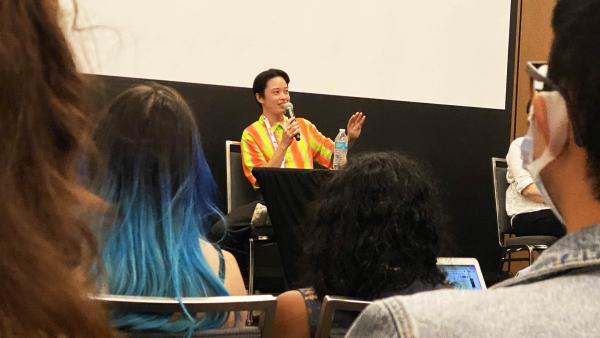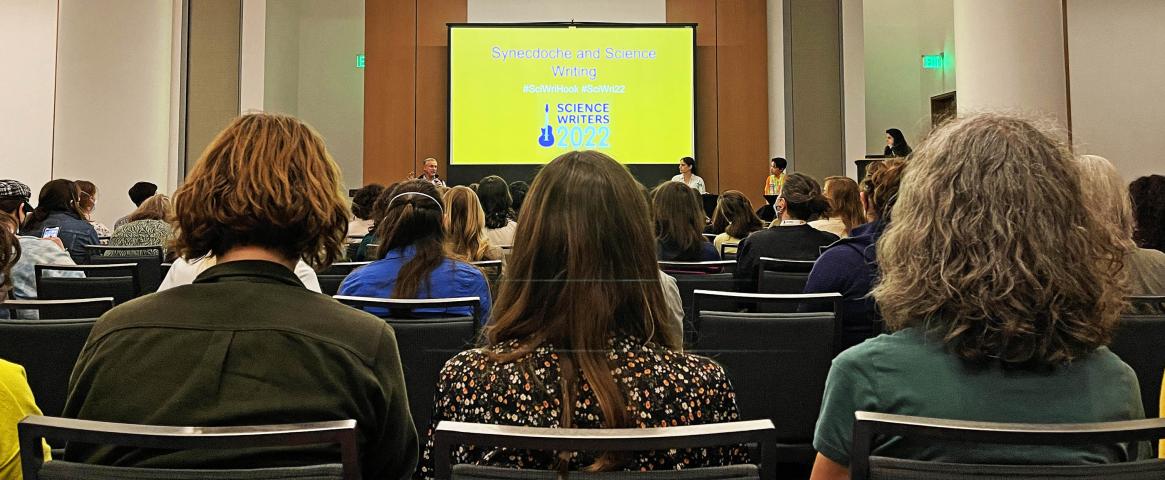Story by Emily Shepherd
Photography by Claire Cleveland and Zoe Grueskin
A cast of essayists convened for the “Synecdoche and Science Writing” NASW workshop (#SciWriHook) at the ScienceWriters2022 annual conference in Memphis. Moderator Maya L. Kapoor, freelance science writer and assistant professor of English at North Carolina State University, introduced each speaker and questioned them on advanced strategies in storytelling.
The panelists were David Quammen, author of Song of the Dodo; Mara Grunbaum, author of WTF Evolution? A Theory of Unintelligible Design; and Sabrina Imbler, author of How Far the Light Reaches.
First though, the brass tacks. What exactly is synecdoche? “My definition of it,” said Quammen, “the one that I've always sort of used instinctively, unconsciously, in my writing is that a synecdoche is a real fact — presented for its relevance as a real fact in your writing — but which also has resonance as a symbol or metaphor.”
Each panelist relayed different ways they used synecdoche in their writing about creatures that are small, slimy, repugnant, or all of the above. For Quammen, the trout were the reason he lived in Montana — both because he made a living by guiding fishing excursions (the fact), but also because the trout were an inextricable part of the grandeur, freedom, and nostalgia of the West (the metaphor).
For Imbler, the mother octopus who would not leave her eggs for months, even to eat, reminded Imbler of their family’s connection to disordered eating. “Through writing about the octopus, I think I was able to access that part of my own story and think about my own experience that feels very uniquely human, but sort of has these ripples out into other species,” they said.
 Sabrina Imbler speaking at ScienceWriters2022. (Zoe Grueskin for NASW)
Sabrina Imbler speaking at ScienceWriters2022. (Zoe Grueskin for NASW)
Kapoor followed by asking Quammen why he wrote about leopards in a nonfiction book about the novel coronavirus. Quammen answered by saying that the leopards of Mumbai live in an urban wildlife sanctuary, surrounded by human habitat. They sometimes kill humans. They are dangerous animals. However, if you were to clone a leopard of Mumbai, “you don't create an animal that doesn't already exist in Mumbai, and doesn't already represent a threat to the dogs, the children and the people in certain neighborhoods,” said Quammen.
This is a metaphor for gain of function research, the subject of much controversy in the mystery of the origins of the COVID-19 pandemic. Quammen explained that research conducted by Shi Zhengli of the Wuhan Institute of Virology had been called gain of function research, or research that would make a virus more deadly. But he said the research was more like cloning a leopard of Mumbai: dangerous, but not more dangerous than the original situation.
“But Maya and I have decided we're pretty sure it doesn't qualify as a synecdoche,” he said, to the audience’s laughter, refiling the leopards as an analogy.
Since all the authors had writing about animal life in common, the conversation turned to anthropomorphizing in science writing. Grunbaum spoke about a “refreshing” experience she had while volunteering for the Seattle Aquarium. “They are actually very encouraging. It's like, tell stories about these animals, give them names, give them pronouns, whatever you can do to help people relate to them. And they didn't talk about it as anthropomorphizing; they talked about it as building empathy.”
A member of the audience mentioned that what’s interesting and what’s important often have “an inverse relationship,” and asked how to reconcile the two. Quammen exclaimed, “climate change!” He then went on to say that climate change is extremely important and extremely boring, and the only time he thought he could write about it was when he heard news of polar bears perishing in unfrozen land.
When another questioner asked to what degree the panelists attempt or don’t attempt to guide the reactions of the reader, Grunbaum said it was a “losing game” to try to get the reader to come away with all the same conclusions as the writer, but she still hoped to sway the reader into caring about the subject matter, and her best tool for this is keeping the logical chain of thought clear through the piece.
Imbler answered the same question by saying “I feel like I'm always in the mindset of like, whoever reads the story, I want this to be their favorite animal, and so I pull out my tool kit.” The tool they mentioned was comparing animals to favorable food items like pizza or TicTacs. In suit, Quammen stated that he did not believe in the “death of the author” theory — but rather, he believed in the intentionality of the author.
Emily Shepherd (@emilyshep1011) is a freelance writer covering science, including wildfire and wildlife conservation. She worked in wildlife conservation for eight years, followed by two years fighting wildfires as a U.S. Forest Service hotshot. Her work has appeared in Eos, Undark Magazine and Terrain.org.
Claire Cleveland (@ClevelandClaire) is a freelance journalist covering reproductive health & justice and LGBTQ+ health and aging.
Zoe Grueskin (@zoegrueling) is a graduate student at the CUNY Newmark Graduate School of Journalism and a freelance science writer working primarily in audio.
This ScienceWriters2022 conference coverage article was produced as part of the NASW Conference Support Grant awarded to Shepherd, Cleveland, and Grueskin to attend the ScienceWriters2022 national conference. Find more 2022 conference coverage at www.nasw.org
A co-production of the National Association of Science Writers (NASW), the Council for the Advancement of Science Writing (CASW), and St. Jude Children's Research Hospital, the ScienceWriters2022 national conference featured an online portion Oct. 12-19, followed by an in-person portion held in Memphis, Tenn. Oct. 21-25. Learn more at www.sciencewriters2022.org and follow the conversation on Twitter at #SciWri22
Credits: Reporting by Emily Shepherd; edited by Ben Young Landis. Photography by Claire Cleveland and Zoe Grueskin; edited by Ben Young Landis




